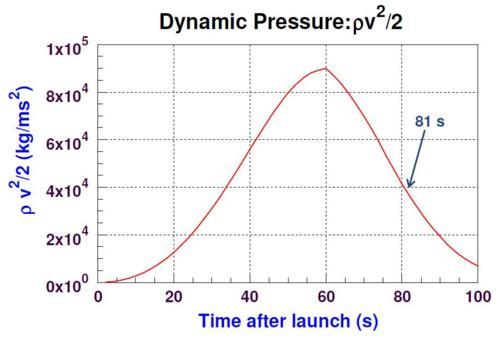
One of the concerns in launching a rocket is the increased stress on the rocket body that is created by atmospheric drag as it accelerates. This is called “atmospheric loading” or “dynamic pressure”, typically denoted by the letter “q”, and is proportional to the density of the atmosphere and the square of the rocket’s speed at any given time. At low altitude the value is small since the speed is small; at high altitude it is small because the atmospheric density is small.
In between there is a maximum value, typically called “Max Q.” This is the point of highest stress on the rocket as it gains altitude.
A recent press story suggested that the breakup of NK’s Unha-3 during its failed satellite launch was due to a mechanical failure at or just after Max Q, and occurred at 81 seconds after launch.
However, the figure above shows the calculation of the dynamic pressure using my computer model of the Unha-3 on its launch trajectory. Max Q occurs at about 60 seconds after launch when the rocket is at an altitude of about 11 km. This is roughly the same altitude that Max Q occurs for the Space Shuttle. At 81 seconds, the dynamic pressure is down to less than half its maximum value, and that is 20 seconds after experiencing the maximum.
Moreover, at 81 seconds the speed of the rocket is about 0.9 km/s, or about Mach 3, so it is well after the point that it has become supersonic.
We still don’t know what happened to the Unha during launch. But this makes me skeptical that it was due to Max Q, unless the times being discussed for the breakup are wrong.
